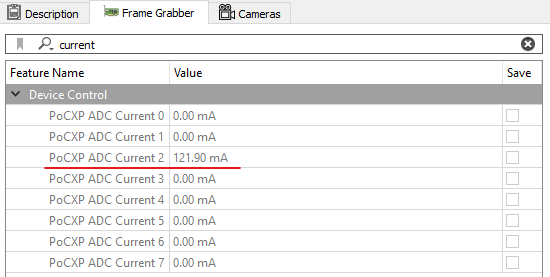PoCXP FAQ
Power Over CoaXPress is a technology in which each CoaXPress connection link of the frame grabber is capable of delivering power to the camera through the CoaXPress cable. This means that the camera can be powered using the only connection from the frame grabber.
PoCXP troubleshoot
If the frame grabber does not power up the CXP camera, follow these steps:
- Ensure that a power supply connector from the PC power supply is connected to the PCIe (6 pin) power input on the frame grabber.
- Do not power the camera via PoCXP and GPIO/external power at the same time! This may cause irreversible damage.
- If the camera requires multiple power connections, verify that all necessary connections are properly made between the camera and the frame grabber.
- Check camera LED statys when the CXP cable is connected to the frame grabber.
- Check voltage current in Vision Point under Frame Grabber properties -> Device Control -> PoCXP ADC current

Example of PoCXP camera connection on channel 2
Automatic PoCXP
Starting from Vision Point 2019.1 (API 5.0) the Automatic PoCXP management was introduced. Full description of this feature is available in KAYA Frame Grabber Feature Guide PDF document.
This feature depends on hardware, firmware, and software compatibility. You can verify its availability in a specific setup (Grabber card, firmware, and software) by checking the Grabber parameter 'PoCXPAutoAvailable'.
KAYA Instruments Service monitors some parameters of CXP connectors, as described below. This is important to note that the following procedure is performed independently for each grabber’s CXP link.
How it works
- When the system starts, the logical state on the connector is 'POWER_OFF'.
- When a camera’s CXP connection is detected (e.g., by plugging a CXP cable from a camera into the grabber), the monitoring procedure powers on the CXP channel and switches its logical state to 'POWER_ON'.
- Connection sensing is implemented by applying a constant current and measuring the voltage on the connection. When a camera is connected, it should provide a certain resistance (as specified by the CXP standard), causing the measured voltage to drop below 'DetectThresholdLow'.
- While in the 'POWER_ON' state, the monitoring procedure measures the current consumed by the connected camera.
- If the measured current falls below a certain 'UndercurrentThreshold' (e.g., if the cable is disconnected from the grabber), the monitoring procedure powers off the CXP channel and switches its logical state to 'POWER_OFF'.
- Additionally, if the measured current exceeds a certain 'OvercurrentThreshold,' the monitoring procedure powers off the CXP channel and switches its logical state to 'POWER_OFF'.
- When a CXP connection is powered on, the camera will need some time to reach the expected current consumption. That’s why there is another logical state between 'POWER_OFF' and 'POWER_ON' — 'WAIT_POWER', to which the monitoring procedure is switching in step 2 above. It then waits some time ('WaitPowerTimeoutMs') before actually switching to the state 'POWER_ON' as described in that step. During that time, no measurements are performed and no other actions are taken.
AutoPoCXP troubleshoot
- Ensure the KAYA Instruments Service is running and is set to automatic start.
- Verify your setup by checking the Grabber parameter "PoCXPAutoAvailable" found in Device Control parameter of the frame grabber.
- Ensure the entire functionality of automatic PoCXP monitoring is activated using the option found in Vision Point -> Tools -> Options. This global setting takes effect after a system reboot and applies to all connected grabbers.
- If the feature is not supported or deactivated, use the "Manual PoCXP Control Configuration" section KAYA Frame Grabber Feature Guide PDF document.